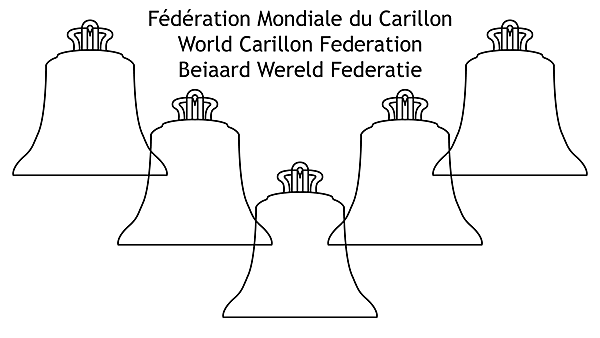News from the Executive Committee of the World Carillon Federation
France | June 7, 2024
International Contest of ADAC
Interview with Adrien Parret, artistic advisor of ADAC, about the International Composition and Arrangement Contest of ADAC (Departmental Association of Friends of the Carillon of Côte d'Or, France).
How did this competition project originate, and what was the objective?
Our association (which aims to bring the 5 carillons of Côte d'Or to life) is celebrating its 50th anniversary. I am firmly convinced that the visibility of our instrument also requires this type of initiative and that it is important to make composers aware of our instrument. This competition is therefore a first attempt and the support of the FMC and the French and Wallonne guilds has greatly encouraged us.
What are the conditions for participating?
Everyone can participate! The regulations are freely available in three languages (English, French, Dutch) on our website. We expect the scores by June 10 at the latest. The only condition to respect: use the imposed theme and, if possible, use Burgundian themes.
How were the Burgundian tunes chosen and what is the point of this type of constraint?
The required theme is the anagram of Balbastre, famous composer from Dijon then organist at Notre-Dame de Paris whose 300th anniversary we are celebrating this year. We also offer other popular themes that composers have the freedom to use or not. It seemed important to us to anchor our competition to its Burgundian roots and to recall the popular aspect of the carillon.
Who are the members of the jury?
 Yves Cuenot, composer, professor at the Dijon conservatory and organist of the cathedral of the same city and the basilica of Vézelay, has kindly agreed to chair this jury
Yves Cuenot, composer, professor at the Dijon conservatory and organist of the cathedral of the same city and the basilica of Vézelay, has kindly agreed to chair this jury
 Vincent Thevenaz, organist and carillonist of Geneva Cathedral, professor at the HEM, international concert pianist
Vincent Thevenaz, organist and carillonist of Geneva Cathedral, professor at the HEM, international concert pianist
 Gauthier Bernard, composer, carillonist of Huy, carillon professor at IMEP, organist of St-Barthélemy in Liège, Belgium
Gauthier Bernard, composer, carillonist of Huy, carillon professor at IMEP, organist of St-Barthélemy in Liège, Belgium
 Elizabeth Vitu, carillonist of Perpignan Cathedral and professor at the conservatory
Elizabeth Vitu, carillonist of Perpignan Cathedral and professor at the conservatory
 Finally, as artistic advisor of the ADAC and carillonneur, I am also a member of the jury
Finally, as artistic advisor of the ADAC and carillonneur, I am also a member of the jury
What will the prizes be? Will the compositions be played?
The prize is 400 euros, and we will also award a prize from the guilds (ACW and GCF) in batches of scores. We have planned the presentation of these prizes on the occasion of the Franco-Belgian days in Dijon on Saturday August 3 during an evening concert at the cathedral. The work that receives the first prize will be performed for the first time during this concert.
Mechelen | Belgium / Flanders | June 7, 2024
Queen Fabiola Competition
Interview with Koen Cosaert, Director of the Royal Carillon School "Jef Denyn" and President of the jury, and Jasper Depraetere, Competition Manager, about the Queen Fabiola Competition.
How was this competition project born and what is the objective?
The Queen Fabiola international carillon competition was created in 1987 on the initiative of Jo Haazen, then director of the carillon school. This competition replaced the old Prosper Verheyden and Léon Henry carillon competitions which were organized each year in Mechelen. The objective of the Fabiola competition was to create an equivalent of the famous Queen Elisabeth competition, a very high level competition. Since 1993, it has taken place every five years.
What are the conditions for participating?
The candidate must have reached the age of 18 at the start of the competition. Candidates must present a repertoire composed of 10 works of a high level of difficulty.
 Four baroque or classical works, including a prelude for carillon by Matthias Vanden Gheyn
Four baroque or classical works, including a prelude for carillon by Matthias Vanden Gheyn
 Three works in the romantic Malinois style, originally written for the carillon
Three works in the romantic Malinois style, originally written for the carillon
 Three works in contemporary style, originally written for the carillon
Three works in contemporary style, originally written for the carillon
The competition rules provide for two compulsory pieces for this edition. The first for solo carillon, 'Rhapsody in Bronze' by Joey Brink, composer and carillonneur from the University of Denver (Colorado, USA), will be played during the pre-selection and on the first day of the final.
The second compulsory piece 'Nocturne' for mobile carillon, piano and percussion by Belgian composer Jeroen Malaise will be played on the second day of the final.
Each participant in the competition is free to take part in the improvisation competition. The improvisation will take place on a theme given during the preselection.
How were the required works chosen and what is the point of this type of constraint?
The required works are newly composed for each competition. We are always looking for a Belgian composer and a foreign composer, both of whom have a certain affinity with the carillon.
This is the third time that the candidates have played a new composition for chamber carillon and ensemble on the last day of the finals. Each time, we choose a different combination to enrich the "carillon + ... " repertoire.
Who are the members of the jury?
The jury is always composed of the director of the carillon school, the carillonneur of the city of Mechelen, teachers of the carillon school and renowned foreign carillonneurs. For the full list, see the competition website.
What will the prizes be?
 First Prize (€ 3,000) : from the Flemish Minister President and Flemish Minister of Foreign Affairs, Culture, Digitization and Facility Management
First Prize (€ 3,000) : from the Flemish Minister President and Flemish Minister of Foreign Affairs, Culture, Digitization and Facility Management
 Second Prize (€ 2,000) : from the City of Mechelen and the Royal Association of Guides of Mechelen asbl
Second Prize (€ 2,000) : from the City of Mechelen and the Royal Association of Guides of Mechelen asbl
 Third Prize (€ 1,500) : from Toren & Beiaard association
Third Prize (€ 1,500) : from Toren & Beiaard association
 Fourth Prize (€ 1,300) : from World Carillon Federation
Fourth Prize (€ 1,300) : from World Carillon Federation
 Fifth Prize (€ 1,000) : from the company Clock-o-Matic, Holsbeek
Fifth Prize (€ 1,000) : from the company Clock-o-Matic, Holsbeek
 Improvisation Prize (€ 1,000) : from the associations Campanae Lovanienses, Roeselaarse Klokkengilde vzw, Carillon Society of Australia
Improvisation Prize (€ 1,000) : from the associations Campanae Lovanienses, Roeselaarse Klokkengilde vzw, Carillon Society of Australia
 Royal Eijsbouts Prize (€ 1,000) : for the best performed Belgian contemporary work (compulsory work by Jeroen Malaise)
Royal Eijsbouts Prize (€ 1,000) : for the best performed Belgian contemporary work (compulsory work by Jeroen Malaise)
 Public Prize (€ 250 + bronze bell) : organized by the Vlaamse Beiaardvereniging
Public Prize (€ 250 + bronze bell) : organized by the Vlaamse Beiaardvereniging
Who are the candidates?
Fifteen candidates participate, eight men and seven women. They come from Belgium, the United States, Canada, Australia and Ukraine. As the jury judges the shortlists anonymously, the names of the candidates will not be disclosed in advance.
Michigan | United States | June 7, 2024
A Century of Women and the Carillon
The website A Century of Women and the Carillon (www.CarillonWomen.org) will reach final completion this summer. This extensive online resource contains articles, multimedia, and maps about the first 50 women around the world to advance carillon culture from the fifteenth century through 1950 in the areas of performance, composition, writing, bellfounding, and philanthropy. The newest website feature is an interactive timeline with descriptions and videos of over forty women from diverse backgrounds who have broken glass ceilings since 1950.
Women have been active throughout carillon history. From 1715-1716, Angela and Anne Therese van de Capelle were paid to perform in Ypres, Belgium. The names of women bellfoundry owners can be found on tower bells from as early as the seventeenth century in the Low Countries. During the early twentieth century, the University of Sydney (Australia) was responsible for professionally appointing more women carillonists than any other institution in the world. New Zealander Gladys Watkins became the first woman to record a carillon album in 1930 with His Master's Voice, including an arrangement of composer Alicia Scott's 'Annie Laurie' (streaming on the website). Utrecht-based composer Catharina van Rennes (the Netherlands) was the first woman to publish her carillon score 'Meidansje' in 1920, and her other compositions were so popular that multiple arrangements were published and recorded in her time (streaming on the website). Women's philanthropy was a driving force behind the growth of American carillon culture in the early twentieth century.
Musical scores by women now in the public domain - written for carillon or written for other instruments and performed before 1950 by women carillonists - are available under the "Resources for Organizers" section of the website. A multi-year research initiative led by Tiffany Ng, Audrey Dye, Scott Orr, and Michelle Lam, www.CarillonWomen.org was co-sponsored by the University of Michigan (USA) and the World Carillon Federation. We thank our 46 contributing authors, plus University of Michigan student researchers Emmet Lewis, Cedric McCoy, Sarah Penrose, and Jasmine Chou.
March 8, 2024
Members of the Executive Committee of the WCF
One of our EC members, Koen Cosaert, has withdrawn from the EC. After a digital consultation with the members of the Committee of Delegates, a candidate has been elected to replace him: Jasper Depraetere, a young professional carillonist from Belgium. The EC would like to thank Koen Cosaert for his efforts for the WCF and welcomes Jasper to the team.
These are the current EC members:
 Koen Van Assche (B), president
Koen Van Assche (B), president
 Audrey Dye (B), vice-president
Audrey Dye (B), vice-president
 Carl Zimmerman (USA), treasurer
Carl Zimmerman (USA), treasurer
 Carol Anne Taylor (USA), secretary
Carol Anne Taylor (USA), secretary
 Peter Bray (AUS)
Peter Bray (AUS)
 Scott Orr (GB)
Scott Orr (GB)
 Vegar Sandholt (N)
Vegar Sandholt (N)
 Jasper Depraetere (B)
Jasper Depraetere (B)
The EC has online meetings, approximately every two months.
WCF grant for carillon competitions
Two candidates have registered after the EC's call for financial support for a carillon competition. According to the WCF budget approved in 2023, a maximum of € 2,500 could be awarded, to be divided into € 500 for composition competitions and € 2,000 for interpretation competitions. After examining the applications, € 250 were awarded to the international carillon composition competition in Burgundy (FR) and € 2,000 to the international carillon competition Fabiola in Mechelen (B).
Subcommittees of the EC
The EC has started various subcommittees to initiate several important achievements.
Subcommittee Communication
This subcommittee consists of EC members Carol Anne Taylor (chair of the subcommittee), Audrey Dye, Peter Bray, Vegar Sandholt, and Carl Zimmerman and is supplemented by external members Mathilde Duriez and Hylke Banning.
They will investigate the best method for a new WCF website and have started a competition for a new WCF logo. They have also started a new WCF newsletter. With this newsletter (4 times a year) the EC hopes to bundle the news from the different countries and create interaction.
Subcommittee Practice Keyboards
This subcommittee consists of EC members Scott Orr, Peter Bray and Koen Van Assche, and is supplemented by external member Keiran Cantilina (chair of the subcommittee). After the first phase of the investigations, other persons with experience in this field will be consulted.
They will investigate the possibility of a low budget build-your-own practice keyboard, for which the EC will bear the costs for the engineering, the prototype and the concrete development, at least if the subcommittee can achieve the goal that the final product will cost maximum € 5,000.
Subcommittee WCF Statutes
This subcommittee (with EC members Carl Zimmerman, Scott Orr and Koen Van Assche) will work on a detailed analysis of the current WCF statutes to investigate which articles require an update. The outcome of this investigation will be presented to the Committee of Delegates during the 2026 WCF Congress.



